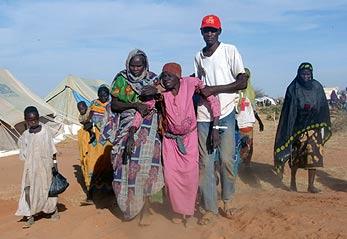Sudanese refugees begin arriving at safer UN camps inside Chad

ADRE, Chad, Jan 19, 2004 (UNHCR) — After months of living on the edge, hundreds of Sudanese refugees have reached safety after being moved from the insecure Chad-Sudan border to an inland site in eastern Chad.
On Monday, a second convoy of some 240 people left Ouendalou border site for the new camp at Farchana, 55 km away. They joined the first group of 148 people who had left on Saturday.
“I feel secure here,” said Dalma, one of the first Sudanese refugees to arrive at Farchana on Saturday. “I feel I can sleep in peace and not fear attacks by the militia.”
Dalma had fled her village of Douat in the Darfur region of western Sudan last September because she said it was attacked by armed men. “About 50 men arrived on horses and camels. They set fire to the houses and stole our cattle. They were also shooting into the air.” Dalma, her husband and their seven children did not even have time to take food or blankets; they left everything behind and walked 15 km before reaching the border with Chad.
They arrived in Ouendalou, eastern Chad – 200m away from the wadi, a river bed that constitutes the natural frontier with Sudan in this area – and built a makeshift shelter with hay. “We thought we would be able to go back to our village soon, so we just settled on the other side of the border,” said Dalma. But five months later, there is still no prospect of a safe return to Douat – and no guarantee of safety in Ouendalou. “The militia crossed the border several times to steal our cattle and scare us,” she said.
Dalma and her family are among an estimated 95,000 Sudanese who have fled across the border to Chad since last March. Scattered in dozens of makeshift camps along a 600-km stretch of remote borderland, the refugees are still vulnerable to periodic incursions by militia from Sudan.
“It is crucial to move them further away from the border to safer sites as soon as possible,” stressed Fabrice Liebaut, a UNHCR emergency protection officer in eastern Chad. “It is already an enormous trauma to be kicked out of your home and in some cases to watch it being burnt, have your few possessions stolen, and see your neighbours being killed. It is a fundamental principle for UNHCR to ensure that these refugees, after what they have been through, can settle in a secure environment until they feel it is safe enough in their country to go back.”
Saturday’s new arrivals at Farchana were received by the Sous-Préfets of Farchana and Adre, and UNHCR staff. After registration and medical screening, each family was allocated a tent on a 96-square-metre plot of land. They also received a 15-day ration of food and a relief package with mats, blankets, a kitchen set, mosquito nets, jerry cans, buckets and soap.
The Farchana site will be able to host between 9,000 and 12,000 people. UNHCR and partners like MSF-Holland, GTZ and the Chadian Red Cross plan to move an average of 200 people every other day, and then progressively increase the movements to a daily basis.
But first, UNHCR and the aid agencies have to locate the refugees, many of whom are scattered in various sites along the border. Other challenges involve transporting them to the new camp on bad roads and explaining to them what they can expect in the new camp.
“Even though many refugees expressed their desire to move to a more secure camp, the relocation still generates a lot of anxiety among them,” said UNHCR’s Liebaut. “Moving away from the border means moving away from their original home in Sudan and from families and friends they might have left behind. We have a lot of families who are separated. So Farchana has this double edge for them: Yes, it means living in a safer place and receiving regular food and assistance, but it also means a jump into the unknown for them.”
UNHCR and the local Chadian authorities are continuing their search for new sites in eastern Chad to relocate more Sudanese refugees before May, when the rainy season will render the sandy roads impassable for heavy trucks. Two possible sites have been identified in the north: Kouloungo, near Guereda, can host up to 20,000 people, while Saranh, further north near Tine, can receive 8,000.
The relocation sites have to meet two main criteria: They have to be located at least 50 km away from the border area to deter militia attacks, and have enough water resources for the refugees.
